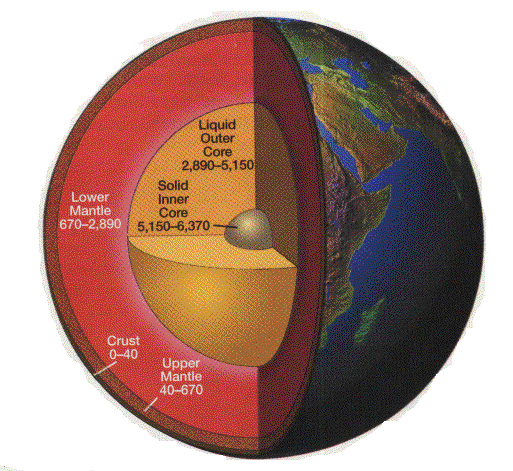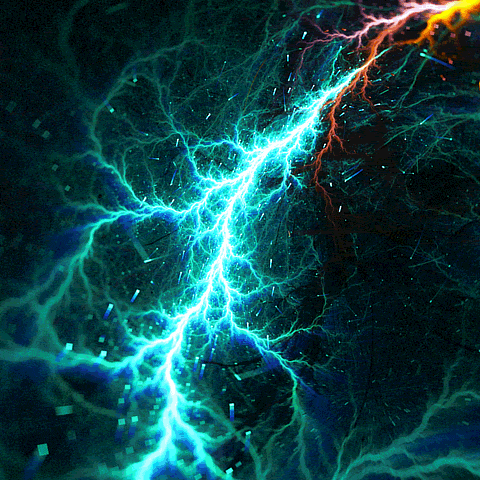

In a previous article, The Origin of the Solar System, some of the many peculiarities of our solar system and its origins were mentioned briefly. The sun for instance is 98% helium and hydrogen, the giant planets are mostly gaseous, but the terrestrial planets including the earth are almost entirely made up of heavier elements-earth is 90% iron, silicon, oxygen and magnesium.
The most popular current secular scientific explanation for the origin of the solar system and the planets suggests that everything formed by a cold accretionary process involving the coalescence, accretion and compression of the abundant gas and dust molecules that "fill" empty space most everywhere.
The Bible, on the other hand describes the formation of the earth's surface as being accomplished by the hand of God from surrounding waters on the Second Day of creation. The sun, moon, stars and other objects in space were specifically made on the Fourth Day. There was light (Hebrew, or) created on Day One (which may explain the present background radiation temperature of space), but the stars themselves (maor), the "light-holders," were not activated until Day Four.
Water is probably the most remarkable substance known to man. Dr. Ed Boudreaux, a nuclear scientist, showed that all the elements of the periodic table could be generated in a matter of hours or days using H2O as a working substance, given temperatures and pressures thought to have existed during the six days of creation week.
Both the secular and the Biblical views would suggest that the earth should be a uniform sphere with all the elements mixed uniformly from crust to core. However this is not what we know to be true. The chart below (1) shows that sometime in earth's early history most of the iron sank to the core while silicon, aluminum, calcium, potassium and sodium have been concentrated in the crust. How did this differentiation come about? The vertical arrangement found within the earth is not according to relative weights.
| Zone | Thickness, km | Density | Temperature, C |
| Atmosphere | ~100 | 10 (exp -9) | ±100 |
| Hydrosphere | 3.8 | 1 | 0-100 |
| Crust (Solid) | 30 | 2.3 | ~100 |
| Mantle (Solid) | 2870 | 4.5 | 2200 |
| Liquid Outer Core | 2230 | 10 | 2300 |
| Solid Inner Core | 1270 | 12 | 3000-6200 |

The answer may be that the elements in the earth occur in the form of compounds having various melting points, chemical activities, and densities. These properties determine the vertical distribution of elements-assuming that the interior of the earth was hot enough to melt everything at some time in the past. (2).
Certain silicates of calcium, sodium, potassium and aluminum, known as feldspars, are easily melted (700-1000 degrees C) and when molten they are relatively light and tend to "float" upwards. Feldspars are common in the earth's crust.
The mantle of the earth, between the crust and the core became the reservoir presumably because magnesium-iron silicates melt less easily than the feldspars, so the principal minerals in the mantle seem to be olivine and pyroxene.
Presumably most of the earth's gold and platinum---inert as far as oxygen is concerned-sank to the core, while other heavier elements such as uranium and thorium formed lighter oxides which rose to accumulate in the crust.
How did the early earth become hot enough for the core to melt? Genesis One suggests the early earth was no colder than ice and no hotter than steam, otherwise the description of the original main continent being brought forth out of the waters (on Day Two as stated in Gen. 1:6) would not be correct. For discussion purposes, if God had "compacted" the sphere of the earth together allowing gravity to do most of the work, the resulting interior temperature would have been less than 1000 degrees C. Iron does not melt, nor could liquid iron sink to the core of the earth where most of it resides today, without the temperature being at least 3700 degrees C. (Heat flow measurements and calculations place an upper limit of about 4300 degrees C as the probable maximum temperature at the center of the earth). (1, 2).
One important feature of the zoning of minerals in the earth is that the radioactive elements are now almost all located in the crust. Careful measurements of heat flowing up from the interior of the earth under the continents, ocean floors, in deep mines and drill holes tells us that most of the interior heat comes from radioactive decay of elements (isotopes of uranium, thorium, potassium) concentrated in the crust in a few parts per million. This heat flow (averaging about 1.5 microcalories per square centimeter per second) adds up to about 250,000 megatons of energy released to the surface per year, a thousand times the energy released by all the earthquakes per year, but 5000 times less than the energy received from the sun.
Radioactive heating of the earth's interior could have provided enough energy to heat the early earth on the interior from 1000 to perhaps 3000 degrees or higher resulting in "core meltdown." When the melting point of iron was reached, it is suggested that iron sank to the core and liberated immediately an additional 1022 megatons of gravitational energy! As this meltdown process took place the radioactive elements floated to the top and became concentrated in the top 10-20 kilometers of crust where they are found today.
Not all astronomers agree with the above model. Those who favor a proto-sun with planetesimals propose a spinning nebula cloud with a plasma disk that cooled from perhaps 5000 degrees at the sun's surface to about 300 degrees at the distance of earth from the sun to 0 degrees at Jupiter's position. In this view, differentiation of the planetary interiors occurred as they were being formed. Depending on the temperature and size of the planet helium and hydrogen were retained or lost (1).
How can this contemporary secular scientific view of earth's early history be fitted to the Genesis record? It is impossible to be dogmatic but this author believes that radioactive processes may have been "switched on" at the time of the fall of man or the angels. The curse on the earth described in Genesis 3 suggests that God decreased the power flow from the spiritual realm into the physical realm at that time. The whole creation then became subject to "the bondage of decay" (3). In physics we see this principal operating today---it is the familiar Second Law of Thermodynamics---the tendency of things to rot, rust, decay, run down and fall apart with the passage of time-as well as the increasing unavailability of energy to do useful work and nature's inexorable tendency towards chaos and disorder.
Thus the creation as it existed at the end of Creation Week operated very differently from the observed behavior of the present universe. The laws of physics have been disrupted and we can not project present data back to t = 0. There have been one or more discontinuities in the laws of nature in the past associated with the fall and with God's miraculous interventions in history. That is, the commonly-held principle of uniformitarianism is invalid---as the Apostle Peter speaks so clearly about in the third chapter of his second epistle.
Radioactive isotopes are unstable (several nuclear processes are involved) because there is insufficient nuclear binding energy in the potential well of the nucleus to contain all the particles of the nucleus. As a result these isotopes spontaneously decay with characteristic half-lives. They emit alpha, beta and gamma particles as they decay and these energies ultimately end up as heat inside the earth. As a side note, the various rates of radioactive decay are mathematically proportional to the velocity of light, and according to the work of Barry Setterfield and Trevor Norman (4: On the Constancy of the Velocity of Light) the rate of radioactive heating of the early earth could have been much faster than it is now. Also, the run rate of the atomic clock is proportional to c-Setterfield and Norman believe the initial value of c at the time of creation was nine to eleven million times greater than the present value. A higher initial velocity of light in the past would indicate a very recent creation of the universe because the atomic clock would slow down with respect to dynamical time if c were higher in the past (5). The statistical evidence that c has decreased in the past 300 years is very strong.
This author suspects that all atomic elements and isotopes were stable before the fall. Not only is man fallen and subject to death, but the evil resulting from the rebellion led by Lucifer has damaged the physical universe as well. Colossians 1:17 states that "all things hold together" in Christ. The Greek word usually translated "consist" can be translated "cohere" or "are compacted together" which suggests that all the forces of nature---especially those which hold the atoms together in stable configurations-are forces that originate in Christ's sustaining power over the creation (6). As the old spiritual suggests, "He's got the whole world in His hands..." (quite literally). Peter the Apostle vividly alludes to these atomic forces being under God's direct control as well (7). Any decrease in the spiritual power which holds the universe "compacted together" would produce a more unstable situation, and a tendency towards chaos and disorder. I believe this instability could have included certain previously stable atomic nuclei becoming radioactive after the fall. Before the fall the universe was probably self-restoring and self-healing, and that state of the affairs will probably be re-established when Christ brings about the new heavens and new earth, making all things new (8). See What Holds the Universe Together?
There is another great mystery in science that would be partially explained by the assumption that radioactive decay was switched on subsequent to the completion of creation week. Thin slices of many crustal rocks (granites for example, but also certain sedimentary rocks such as coalified wood) contain tiny spherical radiation burn rings known as "pleochroic halos." The study of these halos has occupied much of the professional career of a distinguished scientific researcher by the name of Robert Gentry (Ref. 9). If the rocks on the interior of the earth were once molten and formed over millions of years many radioactive elements would have totally decayed long before the rocks crystallized and there would be no halos. It is as if the rocks and their included radioactive isotopes were all created in an instant of time so that the halos began to form immediately in rock that was already differentiated, and cool.
The most puzzling pleochroic halos are those due to Polonium 210. Although the decay of Uranium 238 to Lead 206 involves Polonium as an intermediate daughter isotope, and although the half-life of U238 is 4.5 billion years, some halos are found that clearly had no Uranium parent isotopes. The half life of Po218 is only minutes, yet perfectly clear pleochroic halos from polonium decay are found in the heart of solid rock!
Either the radioactive polonium atoms were frozen nearly instantly into the parent rocks at the "moment" of creation by divine fiat, or the Polonium was not originally radioactive when the rocks crystallized. In either case there is no way to reconcile these Polonium halos with an old universe and the supposedly slow processes (millions of years) of rock formation and slow geologic processes.
In light of Gentry's work it is quite possible that radioactive heating of the earth was not the cause of core meltdown of the early earth after all-the observed differentiation of the elements could have some other cause. If isotopes which were originally stable later became radioactive after they were concentrated by some other mechanism into the crust, the heat released in the crust might help to explain rapid fracturing of the earth's crust at the time of the Flood of Noah, and rapid continental drift perhaps a hundred years later (Ref. 10).
Speaking of the Flood of Noah, various calculations of the amount of water that might have been contained in a vapor canopy above the earth show that most of the water for the flood apparently came not from rainfall, but from the opening of the so-called "fountains of the deep" mentioned in Genesis 7:11. The evidence from many passages of scripture is that very large quantities of water were once trapped within the earth. Most of this water now resides in earth's oceans having been violently released by run-away heating and cracking of the crust at the time of the Flood.
Perhaps the mechanism of the Flood, and its very timing 1656 years after Adam left the garden was all set into motion by Adam's fall. This would be but one example suggested in the Bible that man's sin affects nature, and that the forces of nature are delicately balanced and very much related to the design of the universe with man placed on center stage in the design of things (Ref 11).
See Reference 12 for an excellent contemporary discussion of the large quantities of water believed to be trapped in the earth's crust.

References
1. Robert H. Dott, Jr., Roger L. Batten, and Randall D. Sale, Evolution of the Earth, McGraw Hill, New York, 1971.
2. Frank Press and Raymond Siever, Earth, W. H. Freeman, San Francisco 1974.
3. Romans 8:19-22.
4. See Alan Montgomery and Lambert Dolphin, Is the Velocity of Light Constant in Time?, Galilean Electrodynamics, Vol. 5 #5, Sept./Oct. 1993. PO Box 545, Storrs, CT 06268-0545. Now available on line: Is The Velocity of Light Constant in Time?
5. For additional information on the speed of light controversy see "Burst of the Bubble?" in Koinonia House publication Personal Update for June 1993. Koinonia House.
6. Hebrews 1:1-4.
7. 2 Peter 3:10-11. The Greek word usually translated "dissolved" in this reference to the atomic elements is really "unloosed."
8. Revelation 21.
9. Robert V. Gentry, Creation's Tiny Mystery, Earth Science Associates, Knoxville, TN 1986.
10. Walter T. Brown Jr., PhD., In the Beginning, Center for Scientific Creation, 5612 N. 20th Place, Phoenix, AZ 85016, 1989.
11. Readers who want to explore these matters in more detail should write to the Institute of Creation Research, PO Box 26673, El Cajon, CA 92021 for their catalog, and also obtain the Proceedings of the First and Second International Conferences on Creation held in Pittsburgh in 1986 and 1990. The latter address is 362 Ashland Ave., Pittsburgh, PA 15228.
12. Deep waters, by Lou Bergeron, New Scientist, 30 August 1997.
Note Added: Laboratory measurements of the melting point of iron at the pressures found at the depth of the earth's core suggest the temperature in the core could be as high as 6200 degrees C which is hotter than the surface of the sun. (September 15, 2002) Science Channel, "The Fires Below."

Lambert Dolphin
Email lambert@ldolphin.org
Library
Library Annex (sincle 2018)